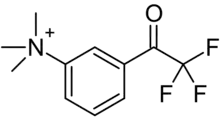TMTFA
TMTFA is an extremely potent acetylcholinesterase inhibitor. As a transition state analog of acetylcholinesterase, TMTFA is able to inhibit acetylcholinesterase at extremely low concentrations (within the femtomolar range), making it one of the most potent acetylcholinesterase inhibitors known.[2][3][4]
 | |
| Names | |
|---|---|
| Preferred IUPAC name
N,N,N-Trimethyl-3-(trifluoroacetyl)anilinium | |
| Identifiers | |
CAS Number |
|
3D model (JSmol) |
|
| ChemSpider | |
PubChem CID |
|
| UNII | |
CompTox Dashboard (EPA) |
|
InChI
| |
SMILES
| |
| Properties | |
Chemical formula |
C11H13F3NO |
| Molar mass | 232.226 g·mol−1 |
| Hazards | |
| Lethal dose or concentration (LD, LC): | |
LD50 (median dose) |
1.6 mg/kg (intraperitoneal, mice) (as iodide salt)[1] |
Except where otherwise noted, data are given for materials in their standard state (at 25 °C [77 °F], 100 kPa).
Infobox references | |
Mechanism of action
TMTFA has a reactive ketone group that can covalently bind to the serine residue in the active site of acetylcholinesterase. This is due to the electron-withdrawing trifluoromethyl group on the carbonyl group.[5]
See also
- Acetylcholinesterase inhibitor
- Methylfluorophosphonylcholine
- Transition state analog
References
- Brodbeck, U.; Schweikert, K.; Gentinetta, R.; Rottenberg, M. (April 1979). "Fluorinated aldehydes and ketones acting as quasi-substrate inhibitors of acetylcholinesterase". Biochimica et Biophysica Acta (BBA) - Enzymology. 567 (2): 357–369. doi:10.1016/0005-2744(79)90122-0. PMID 444532.
- Nair, Haridasan K.; Lee, Keun; Quinn, Daniel M. (November 1993). "m-(N,N,N-Trimethylammonio)trifluoroacetophenone: a femtomolar inhibitor of acetylcholinesterase". Journal of the American Chemical Society. 115 (22): 9939–9941. doi:10.1021/ja00075a009.
- Kua J, Zhang Y, McCammon JA. Studying enzyme binding specificity in acetylcholinesterase using a combined molecular dynamics and multiple docking approach. J Am Chem Soc. 2002 Jul 17;124(28):8260-7. doi:10.1021/ja020429l PMID 12105904
- Butini S, Campiani G, Borriello M, Gemma S, Panico A, Persico M, Catalanotti B, Ros S, Brindisi M, Agnusdei M, Fiorini I, Nacci V, Novellino E, Belinskaya T, Saxena A, Fattorusso C. Exploiting protein fluctuations at the active-site gorge of human cholinesterases: further optimization of the design strategy to develop extremely potent inhibitors. J Med Chem. 2008 Jun 12;51(11):3154-70. PMID 18479118doi:10.1021/jm701253t
- Harel, Michal; Quinn, Daniel M.; Nair, Haridasan K.; Silman, Israel; Sussman, Joel L. (January 1996). "The X-ray Structure of a Transition State Analog Complex Reveals the Molecular Origins of the Catalytic Power and Substrate Specificity of Acetylcholinesterase". Journal of the American Chemical Society. 118 (10): 2340–2346. doi:10.1021/ja952232h.
This article is issued from Wikipedia. The text is licensed under Creative Commons - Attribution - Sharealike. Additional terms may apply for the media files.